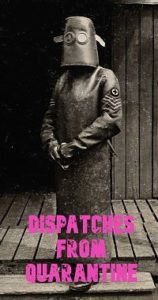 Last Wednesday we were conducting business as usual. By Friday, the final four productions of the Alliance Theatre’s 51st season—Naked Mole Rat Gets Dressed: The Rock Experience, 53% Of, In My Granny’s Garden, and Sweat—had been suspended due to concerns over the proliferation and potential community spread of COVID-19 in Atlanta. The theatre’s education programming also became a casualty of the pandemic, with in-school programs, classes, workshops, and festivals being postponed, if not outright cancelled. Last Thursday, as the Alliance’s education staff scrolled through our social media feeds to see that Broadway would be going dark, a live feed played in our conference room of Georgia Gov. Brian Kemp announcing that schools, childcare providers, and local governments had the option to close for two weeks. The fact was undeniable: Our closure might prove temporary, but it was imminent and inevitable.
Last Wednesday we were conducting business as usual. By Friday, the final four productions of the Alliance Theatre’s 51st season—Naked Mole Rat Gets Dressed: The Rock Experience, 53% Of, In My Granny’s Garden, and Sweat—had been suspended due to concerns over the proliferation and potential community spread of COVID-19 in Atlanta. The theatre’s education programming also became a casualty of the pandemic, with in-school programs, classes, workshops, and festivals being postponed, if not outright cancelled. Last Thursday, as the Alliance’s education staff scrolled through our social media feeds to see that Broadway would be going dark, a live feed played in our conference room of Georgia Gov. Brian Kemp announcing that schools, childcare providers, and local governments had the option to close for two weeks. The fact was undeniable: Our closure might prove temporary, but it was imminent and inevitable.

In an email sent to the company just before 11 a.m. on Friday the 13th, Alliance Theatre leadership had assured its full-time and seasonal staff that we would continue to “remain on payroll without interruption” while managers developed contingency plans for their staff to telework. Our focus would now be supporting and planning the upcoming 2020-21 season. Administrators would continue working, albeit remotely.
Not accounting for the work that plays on our stages, the Alliance Theatre Education department employs several dozen part-time artists who work in a slew of various capacities for at least a dozen program initiatives. As part of the Alliance Theatre Institute, artists go into schools to teach specialized lessons for pre-K to 12 classrooms on subjects varying from dramaturgy to musical theatre to playwriting. In our acting program, artists command classrooms and studios on the Woodruff Arts Center campus as they offer their expertise to students of all ages. These artists can be found with the Alliance Theatre’s Teen Ensemble, inside YMCA classrooms, and in several Boys & Girls Clubs across metropolitan Atlanta. For many this work is a primary source of their income.
Though it is the ethical and moral duty of cultural institutions to protect the health of their patrons, their staff, their volunteers, and their artists by closing doors at the onset of COVID-19 to help contain its imminent spread, what does this mean for artists who lose their livelihood and face devastating financial repercussions in the meantime? I believe it is also our ethical and moral duty as administrators and culture workers in large institutions not only to help protect our communities from infection, but also to find immediate and creative solutions to the sudden unemployment of artists whose skill and labor we rely on to advance the mission of our organization. But the proximity of theatre artists to each other, and to large groups of people, is foundational to the art form, and with guidelines from the World Health Organization and Center for Disease Control recommending we practice social distancing, congregating in the same physical space is out. So how do we solve this problem?
By using tools already at our disposal. Once a mere exploratory interest, engaging audiences and patrons in digital spaces is now an immediate and long-term necessity for the health of both the not-for-profit theatre and the artists whose work it stands on. There exists a multitude of online spaces for theatrical voices, and we should look to them for guidance and leadership as we work towards creative solutions for making these digital platforms hospitable both during social distancing and after. We have a sudden opportunity to radically expand and challenge our preconceived assumptions about how we occupy space and engage in theatrical narratives while providing more job opportunities for artists and radically increasing access to wider swathes of our communities.
Technology does have limitations. The internet, as it exists today, is viewed less as a utility and more as a luxury, and many don’t have it in their homes at all. Punctuality isn’t a prerequisite of attendance for an online engagement. Performers and lecturers can’t read or feel a crowd’s energy through a screen. Perhaps most detrimental to an inherently physicalized and local artform: The audience cannot feel the performer’s energy, either. As it stands, nothing can replace nor replicate the experience of a live performance.
But isolation due to pandemic has revolutionized the arts and sciences before. (King Lear was trending on Twitter over the weekend for having been written by Shakespeare, some scholars believe, while he was in quarantine from the plague; Newton, too, discovered calculus while isolated.) Moving our operations online may not beget genius, but it could inspire and transform the work of artists and administrators alike. There also lies an opportunity to radically expand our definitions of “local” and “community,” no longer limited by geographic and socioeconomic barriers. If a theatre’s work in New York can be viewed regularly by students in Georgia, the accessibility and exposure of that work is, if not exactly equal to those in proximity of the performance space, exponentially increased.
Online culture has its own ways of defining community. Social media platforms act as localized coteries defined not by relative geographic location but by fandom, by aesthetic, by interest. Live dramatic narratives can be found, of all places, on Twitter. Perhaps one of the most famous, #TheStory by Aziah “Zola” Wells, is a 148-tweet magnum opus that went viral (in the other sense of the word) in 2015 and inspired a movie produced by A24 and written by director Janicza Bravo and Slave Play’s Jeremy O’Harris. For those of us who watched the story unfold as it was written, there was an unmistakable theatrical quality to the way we engaged with #TheStory: together, in the same digital space, reacting in real time.
Fortunately there are progressive organizations who have been advancing our understanding about the intersection of digital spaces with theater and live performance. HowlRound Theatre Commons “…amplif[ies] progressive, disruptive ideas about theatre and facilitate[s] connection between diverse practitioners.” The essay Ways of Gathering in the Age of COVID-19, speaks to this immediate need, with recommendations for events to go on as scheduled, albeit in formats outside our traditional ways of working.
It is encouraging to see how theatre practitioners and cultural institutions have adapted to online environments. The Metropolitan Opera is offering nightly Met Opera streams in HD to their audience for free, for instance. Locally, in Atlanta, Dad’s Garage Theatre Company will be offering content through a Twitch channel—a platform normally reserved for live streamed gaming content. The Center for Puppetry Arts continues to offer Digital Learning and interactive puppet shows streamed directly into homes. Here at the Alliance Theatre we’ve made preparations to use video content from our production of Naked Mole Rat Gets Dressed: The Rock Experience to work as interactive lessons in choreography, costume design, singing, and public speaking, which students can engage with in their homes.
Many theatres, including my own, have also made a commitment to pay the artists who have lost out on gigs due to the coronavirus. This is a privilege that comes with considerable resources and will not be available to all. With that privilege, however, comes the responsibility to use those resources to best take advantage of the moment for the good of the artists who depend on us. We are in the midst of a challenging time for arts and culture workers. But as with the most inspirational and creative theatre, I believe that elegant solutions can be made from remarkable constraints.
Patrick Myers is the education coordinator for the Alliance Theatre at Woodruff Arts Center in Atlanta, Ga.

